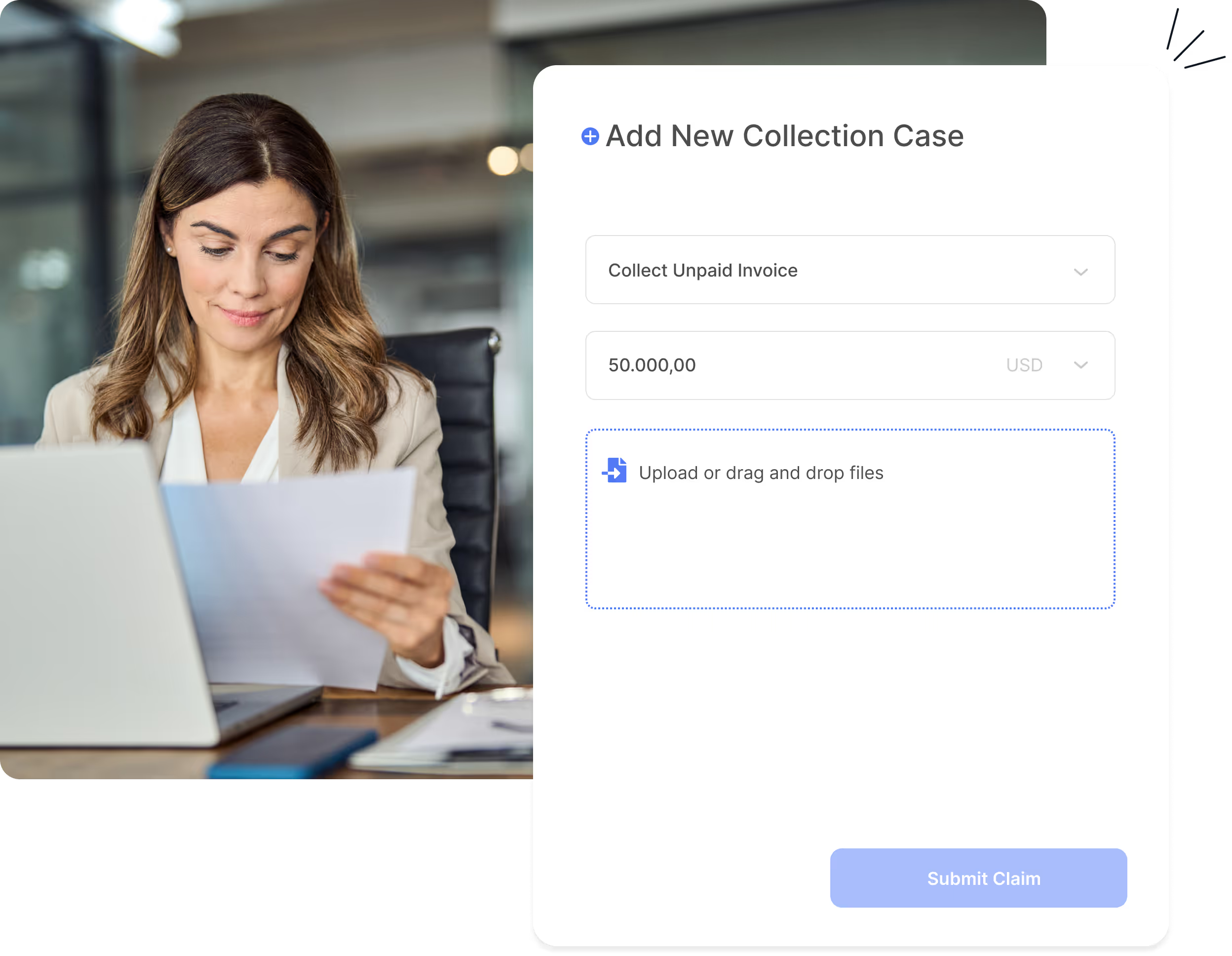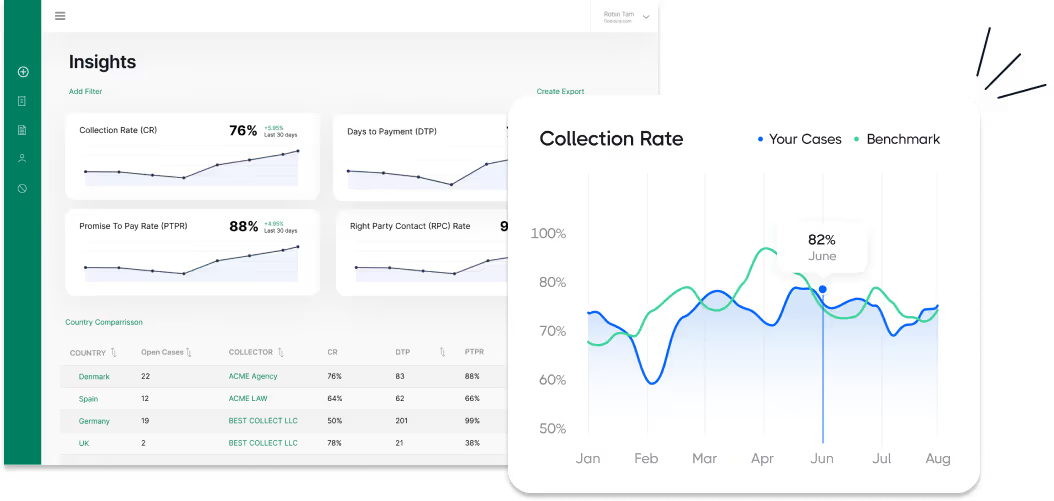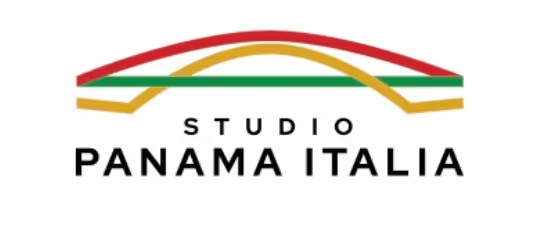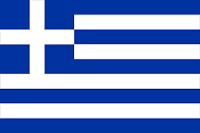Top-Rated Debt Collection Agency in Panama
Your trusted debt collection agency in Panama guarantees secure, fee-less recoveries. Get familiar with local collection procedures through our comprehensive guide.






The ultimate guide about debt collection in Panama
Why you can trust this guide
At Debitura, we uphold the highest standards of impartiality and precision to bring you comprehensive guides on international debt collection. Our editorial team boasts over a decade of specialized experience in this domain.
Questions or feedback? Email us at contact@debitura.com — we update this guide based on your input.
Debitura By the Numbers:
- 10+ years focused on international debt collection
- 100+ local attorneys in our partner network
- $100M+ recovered for clients in the last 18 months
- 4.97/5 average rating from 600+ client reviews
Expert-led, locally validated
Written by Robin Tam (16 years in global B2B debt recovery). Every page is reviewed by top local attorneys to ensure legal accuracy and practical steps you can use.
Contributing local experts:
Last updated:
Embark on your debt collection journey in Panama with our comprehensive guide. Simplify the recovery process by leveraging Debitura's local expertise and vast international knowledge. Stay ahead by being adept in overcoming any debt collection hurdles in Panama.
Understanding Panama's Debt Recovery Landscape
To navigate Panama's intricate debt recovery scenario, it is vital to grasp the various key roles and responsibilities of crucial participants. This includes debt collection agencies, bailiffs, and lawyers, each of whom contributes significantly to the lawful orchestration of recovering debts in Panama.
Debt Collection Agencies in Panama
Debt collection agencies play an instrumental role in Panama's financial health by bridging the gap between creditors and debtors. These entities step into the debt recovery scenario once standard communication and preliminary recovery efforts by the creditor prove insufficient. The typical tasks performed by these agencies include sending formal demand letters, conducting direct negotiations, and utilizing communication channels like phone calls and emails to urge debt repayment. While these agencies strategize to recover debts through amicable means, it's crucial to note their operational scope. Their actions are circumscribed within the framework of legal regulations which safeguard debtors against unfair practices, ensuring that the collection process respects the dignity and rights of the involved parties. Creditors often resort to these agencies as a preliminary step before considering any judicial collection procedures, aiming for a resolution that doesn't require judicial intervention.
The Role of Lawyers in Panama's Debt Recovery Process
In the realm of debt recovery in Panama, the expertise of lawyers is often pivotal, especially in situations where judicial intervention becomes necessary. These legal professionals are crucial for the successful navigation through the complexities of Panama's judicial system, handling the preparation and submission of necessary legal filings, and acting as the creditor's advocate in court. Lawyers become imperative when extrajudicial attempts at debt collection have been exhausted and a legal route is deemed the most viable option for recovery. Tasks typically managed by lawyers include drafting legal notices, representing the creditor in legal proceedings, and ensuring compliance with Panama's stringent debt collection regulations. With their comprehensive knowledge of local laws and procedural nuances, lawyers play a vital role in facilitating the enforcement of judicial decisions, such as the seizure of assets or the imposition of fines on a debtor. Their involvement is key not just in safeguarding the creditor's interests, but also in expediting the recovery process in an efficient and legally sound manner.
The Integral Role of Bailiffs in Panama's Debt Recovery
In Panama, the deference of bailiffs, known locally as "alguaciles," is pivotal for the enforcement of debt recovery through judicial pathways. Tasked with executing court orders, their role commences once all mandatory pre-judicial avenues, including negotiation and arbitration, fail to culminate in debt recovery. A creditor may petition for a bailiff's intervention typically after obtaining a court judgment, deemed an "executive title," against the debtor. This formally indicates the debtor's obligation to settle the outstanding debt, having surpassed the 90-day grace period post the expiration of payment terms.
Bailiffs are instrumental in executing asset seizures, facilitating the sale of these assets through public auctions, and ensuring the proper service of legal documents to the concerned parties. This chain of tasks necessitates the garnishment of wages or bank accounts and lockouts, strictly adhering to Panama's legal framework to safeguard the interests of both creditors and debtors. Before a bailiff's engagement, creditors must furnish executive titles—such as court judgments, public deeds, or private documents acknowledged by the debtor—demonstrating a clear path from the initial claim to legal enforcement. The precise regulatory environment in which they operate mandates their actions to be rigorous yet fair, establishing a structured approach towards equitable debt enforcement in Panama.
Navigating Debt Recovery Laws in Panama
Proficient debt reclaiming in Panama is anchored on the comprehensive understanding of its intricate legal systems. Ensuring adherence to these laws guarantees not just efficient debt recuperation, but also promotes the principles of fair play, a pivotal aspect for robust business integrity and trust.
The Regulatory Environment and Civil Court System in Panama
Panama's civil court system is pivotal in managing civil disputes, including debt collection, and plays a fundamental role in the country's legal framework.
- First Instance Courts (Juzgados de Primera Instancia): These courts serve as the entry point for civil disputes in Panama. They handle a wide range of civil cases, providing the first level of judgment. Decisions from these courts can be appealed.
- Appellate Courts (Tribunales Superiores): The next tier in the hierarchy, these courts review decisions made by the First Instance Courts. Their role is to ensure that the law has been applied correctly and that due process was followed in the initial proceedings.
- Supreme Court of Justice (Corte Suprema de Justicia): As the apex of the judicial system in Panama, the Supreme Court oversees appeals from the Appellate Courts. It ensures uniform interpretation of the law and sets legal precedents.
In summary, Panama's civil court system is structured to ensure justice and fairness through a tiered approach that allows for review and appeal of decisions. This system plays a crucial role in upholding legal standards and resolving disputes effectively in the country.
Key Legislation Impacting Debt Collection in Panama
In Panama, the legal framework for debt collection balances the rights of creditors and debtors, ensuring fair and efficient recovery processes.
- Law 60 of 2008: Governs debt prescription, stating actions from financial contracts prescribe after three years, allowing consumers to request prescription under certain conditions.
- Law 24 of 2002, amended by Law 195 of 2020: Regulates credit history prescription, where active or canceled references expire after five years from the last payment reflected. The amendment benefits Panamanians retroactively, ensuring prescribed references are removed.
- Law 401 of 2023: Introduces temporary measures for tax recovery and a special transitional treatment for tax debt management, including provisions for declaring certain tax debts as prescribed.
These laws underline Panama's commitment to a transparent and just debt collection ecosystem. By recognizing the importance of consumer protection while ensuring creditors can recover owed amounts, Panama fosters a healthy financial environment for both local and international stakeholders.
Consumer Protection from Unfair Collection Practices in Panama
In Panama, the landscape of debt collection is navigated by strict consumer protection laws aimed at ensuring fair practices and safeguarding debtor's rights. These laws balance the creditor’s need for recovery and the consumer’s right to fair treatment.
- Law 60 of 2008: Establishes that actions from financial contracts prescribe after three years, offering consumers a recourse to request prescription of their debt.
- Law 24 of 2002 as amended by Law 195 of 2020: Governs credit history, stating that active or canceled references expire after five years from the last payment, thus impacting consumer’s credit report positively after prescription.
- Payment Arrangements under Article 1784 of the Panamanian Judicial Code: Enables debtors to request a payment plan approved by a judge, helping those unable to pay in full to settle their debts over time.
- Consumer Engagement with Financial Institutions: Encourages negotiation with financial institutions for debt settlement, fostering a positive credit environment and financial health.
- Resources for Violations: Provides legal channels such as the Superintendence of Banks or Acodeco Executor Court for consumers to seek recourse if a debt collector violates their rights.
These frameworks ensure that debt collection in Panama respects consumer rights, promotes financial responsibility, and provides avenues for consumers to manage or contest their debts effectively. By balancing creditors’ recovery efforts with protective consumer legislation, Panama fosters a fair and just financial ecosystem.
Navigating Amicable Debt Collection in Panama
Unpacking amicable or pre-legal debt collection in Panama, an efficient process to negotiate debt settlements without court mediations. This quicker and less intricate method is often employed by debt collection agencies, offering an overview of the approach, tactics, and key factors to consider.
- Statute of Limitations: Three-year limitation for financial contracts under Law 60 of 2008.
- Credit History Prescription: Credit references expire after five years, per Law 24 of 2002, amended by Law 195 of 2020.
- Tax Debt Management: New provisions for tax debt recovery under Law 401 of 2023.
- Amicable vs. Judicial Recovery: Amicable recovery preferred for its cost-efficiency and shorter timeframe.
- Judicial Collection Requirements: Requires knowing debtor's location and asset presence before proceeding.
- Consumer Protection: Debtors can request debt prescription, with limitations under specific laws.
- Legal and Collection Fees: Includes late payment surcharges, legal, and collection agency fees.
- Statutory Interest Rates: Adhere to rates provided by the Superintendencia de Bancos de Panamá.
- Advisors' Role: Legal and financial advisors are critical for compliance and optimization.
- Consumer Rights: Debtors have rights including disputing collection practices and requesting debt prescription.
Navigating Amicable Debt Collection in Panama
In Panama, amicable debt collection is a key first step in the debt recovery process, leveraging negotiation and cooperation to reconcile debts without resorting to judicial proceedings. This route capitalizes on understanding and empathy, striving for an arrangement that balances the debtor's capacity to pay with the creditor's need for recovery. It's especially pertinent in environments like Panama where legal actions can be lengthy and costly, making amicable resolution a preferred initial approach.
For international creditors, starting with amicable collection is advisable unless facing disputed claims or intricate legal issues. This strategy not only saves on legal expenses but also aids in preserving business relationships.
The Collection Agency's Role in Amicable Debt Recovery in Panama
Agencies like Debitura play a crucial role in Panama’s amicable debt recovery, offering expertise that creditors might not possess. Our method involves accurately identifying the debt and the debtor, followed by initiating amicable dialogue through reminders or formal notices. This impartial mediation often culminates in successful debt recovery, owed to our professional detachment and understanding of local practices and laws, such as Law 60 of 2008 regarding debt prescription and Law 24 of 2002, amended by Law 195 of 2020, regarding credit history prescription.
Advantages of Amicable Debt Resolution
Adopting an amicable approach to debt collection in Panama is advantageous for both creditors and debtors. It minimizes legal expenses and fosters a constructive creditor-debtor relationship, often leading to more feasible repayment plans for the debtor. This harmonious strategy underscores mutual respect and comprehension, creating a favorable atmosphere for financial commitment fulfillment.
Transitioning from Amicable to Legal Collection in Panama
While amicable debt collection holds numerous benefits, there are scenarios where legal action becomes imperative. Indicators for escalating to legal proceedings include persistent non-responsiveness, recurring defaults, or intentional avoidance by the debtor. This crucial step should be considered judiciously, as legal processes entail significant costs and durations. Transition often occurs after all amicable avenues have been explored.
Amicable Debt Collection Costs in Panama
Debitura provides a transparent, risk-free service for international debt collection in Panama, embracing a "no-success, no-fee" model to assure value. We eliminate upfront costs, allowing you to start without setup fees or subscriptions. Fees range between 7.5% to 30%, contingent on successful recovery. Begin without hassle by signing up for free, uploading your claim, and receiving a tailored quote. Discover more about our pricing.
How it Works
Debitura’s approach to amicable debt recovery in Panama is straightforward and typically spans 2-3 months:
- Sign Up for Free: Begin without initial expenses. Register your account today.
- Upload Your Claim: Submit your claim, review the success fee, and confirm to initiate.
- Track Progress: Follow the amicable recovery journey in real-time through your Debitura dashboard.
- Consider Legal Action: If unresolved, we’ll present three quotations from local lawyers for potential judicial proceedings, empowering you to decide your next move.
Understanding Legal Debt Collection in Panama
Moving beyond amicable settlements, the world of judicial or legal debt collection opens up. It involves securing court orders and employing bailiffs to enforce claims. In this section, we offer a succinct, yet detailed, walkthrough of Panama's unique judicial debt collection process.
- Debt Prescription: Financial contract actions prescribe after three years, as per Law 60 of 2008.
- Credit History Prescription: Law 24 of 2002 ensures credit references expire after five years from the last payment.
- Tax Debt Management: Law 401 of 2023 aims to streamline tax debt recovery, affecting debts for fiscal years 2015 or earlier.
- Payment Arrangements: Before asset auctions, debtors can arrange full payment or judge-approved installments.
- Consumer Protection: Rights include requesting debt prescription and engaging in debt settlement agreements.
- Initiation of Judicial Process: Begins with asset freezing when amicable agreements fail, potentially leading to asset seizure.
- Executive Title Requirement: Legal reforms emphasize the need for an executive title to initiate collection, serving as prime evidence.
- Property Valuation Reform: Law 415 of 2023 introduces fair market value assessment methods for debt recovery.
- Civil Courts Jurisdiction: Debt recovery cases typically fall under civil courts based on the debt's location or debtor's residence.
- Impact on Credit Scores: Payment arrangements and settling debts influence credit history and financial health.
Shifting from Amicable to Judicial Debt Collection in Panama
In Panama, like in many jurisdictions, debt recovery proceeds through two primary stages: amicable (non-judicial) and judicial debt collection. Amicable collection focuses on negotiation and voluntary compliance, often involving friendly reminders, negotiation, and repayment plans. However, when these efforts fail due to disputes or the debtor's unwillingness to pay, creditors can escalate to judicial debt collection. This transition is essential when there is a need for formal debt enforcement or when the creditor seeks to leverage legal mechanisms to secure payment.
Engaging legal counsel or representation becomes crucial in Panama's judicial debt recovery process. Legal professionals guide creditors through the complex legal framework, ensuring proper filing of lawsuits and adherence to procedural requirements, ultimately maximizing the chances of successful debt recovery.
The Importance of a Formal Judgment in Panama
In Panama, obtaining a formal court order or judgment is a critical step in the judicial debt collection process. A court order validates the debt legally and provides creditors with the means to enforce their claim against debtors through state mechanisms. It holds significant importance for debt recovery, allowing for actions such as asset freezing, withdrawal, auction, and commercial blacklisting of the debtor.
To obtain a court order in Panama, creditors must initiate a judicial debt collection process. This entails filing a lawsuit with appropriate documentation, such as invoices and certificates signed by the debtor. The process includes notifying the debtor about the lawsuit, seizing and auctioning off assets if necessary, and potentially listing the debtor's name in commercial bulletins. Timely and proper legal action ensures creditors can effectively enforce their claims with a court order.
Determining the Appropriate Court in Panama
In Panama, determining the correct judicial venue for debt recovery involves several criteria, including claim size, complexity, and the nature of the debt. For smaller claims, the use of small claims court or Juzgado de Pequeñas Causas is often preferred due to its streamlined process and faster resolution times. This court handles disputes where the claim amount falls below a specific threshold, offering an accessible avenue for resolving minor matters efficiently.
For larger or more complex claims, the process typically falls under the jurisdiction of the civil courts, which handle a wider range of legal disputes, including debt recovery. These courts are equipped to handle the procedural and evidentiary requirements of larger cases, including those involving significant asset seizures or complex contractual disputes.
It's essential for creditors to consider the nature and value of their claim to decide on the appropriate court correctly. Legal counsel can play a crucial role in this decision, advising on the best track to ensure effective enforcement of debt recovery efforts in Panama.
Small Claims Court in Panama
In Panama, the Small Claims Court, referred to locally as "Juzgado de Pequeñas Causas," offers a streamlined and less formal venue for resolving disputes involving smaller sums of money. This system is designed to expedite the resolution of claims that fall below a certain financial threshold, which helps to alleviate the burden on the broader judicial system. The specific financial limit for cases to be considered under the Small Claims process can vary, and it’s advisable to check the most current regulations or consult with a legal professional for up-to-date information. This court plays a critical role in providing an accessible, efficient, and cost-effective means for individuals and businesses to seek justice in debt recovery issues without the need for extensive legal representation. The objective is to facilitate quicker resolutions, reducing the time and expense typically associated with traditional court proceedings, and making the legal process more approachable for all parties involved.
Ordinary Proceedings in Panama
In Panama, ordinary proceedings represent a detailed judicial process intended for resolving disputes that exceed the monetary or complexity limits of small claims court. Unlike the more concise and informal structure of small claims, ordinary proceedings allow for a broader exploration of evidence and legal arguments. This procedure offers several advantages, including comprehensive review and handling of complex legal and factual issues, catering to disputes where the amounts or legal questions involved demand thorough examination.
One of the significant elements distinguishing ordinary proceedings from small claims court is the requirement for legal representation. Parties involved in ordinary proceedings are generally required to be represented by an attorney, ensuring that their legal interests are adequately protected and argued with the required legal expertise. This aspect underscores the complexity and formal nature of these proceedings.
The framework governing ordinary proceedings is detailed within Panama's judicial system, adhering to procedures specified in the Panamanian Judicial Code. This system is designed to balance fairness and efficiency, obtaining just outcomes for parties while managing the demands of judicial resources. Laws such as Law 415 of 2023 aim to streamline processes and improve transparency, emphasizing the importance of fair and expedited judicial resolution for both creditors and debtors.
Navigating Debt Execution in Panama
Upon successful judicial acquisition of a debt collection order in Panama, the stage of debt enforcement begins. This stage grants the authority to seize the debtor's assets under official supervision, guaranteeing the realization of owed claims.
- Judicial Debt Collection: Used as a last resort in Panama, commencing typically 90 days after payment terms expire.
- Preventive Measures: Panamanian law mandates preventive and extrajudicial periods prior to judicial proceedings for debt recovery.
- Asset Consequences: Non-payment may result in asset freezing, seizure, and auction to satisfy debt obligations.
- Financial Restrictions: Debtors may face restrictions on credit and banking services for at least five years for non-payment.
- Executive Titles: Includes court judgments and documents with debtor's signature to initiate executive processes for debt collection.
- Stages of Executive Processes: Involves claim filing, payment order issue, notification, auctions, and adjudications.
- Asset Seizure: Embargoes in debt collection involve asset seizing with specific types of assets that can be embargoed.
- Auction Process: Judicial auctions conducted to sell seized assets with a deposit requirement for participation.
- Legal Documentation: Specific documents like court judgments, public deeds needed before executing debts.
- Consumer Protection: Laws govern debt prescription and credit history, offering avenues for debt and credit history clearance.
Understanding Executive Titles in Panama's Debt Enforcement
In Panama, the initiation of the debt enforcement process is contingent upon the creditor's possession of an "executive title" – a fundamental concept that includes judicial decisions, public deeds, or private agreements validated by the debtor’s acknowledged signature. This legal construct is pivotal because it provides an unequivocal affirmation of the debt owed, which, in turn, permits the judicial system to enact measures such as asset freezing and seizure, thereby safeguarding the creditor’s interests.
The Procedure of Asset Seizure and Auction
Following the validation of an executive title, the next steps involve identifying and seizing the debtor's assets, which may range from real estate to personal vehicles. However, the law also ensures that the debtor is left with basic living necessities; hence certain personal items and a minimum income level are exempt from seizure. Once assets are seized, they are usually sold through judicial auctions. The proceeds from these sales are then allocated to satisfy the creditor's claims, with the entire process being conducted under strict judicial oversight to ensure fairness and legality.
Judicial Auctions and Their Impact
Judicial auctions play a pivotal role in Panama’s debt enforcement landscape. To participate, potential buyers must deposit a guarantee, underscoring the auction's seriousness. This system sees assets being initially offered at two-thirds of their assessed value. If not sold, the assets may be offered at a subsequent auction at a reduced minimum or without a reserve price, to expedite the recovery process. Importantly, recent legal adjustments have refined the criteria for asset valuation, aiming to harmonize the expectations of all parties involved and enhance the efficacy of the auction process.
Navigating Debt Enforcement with Respect to New Legislation
The landscape of debt enforcement in Panama is also influenced by recent legislative changes, notably through Law 401 of 2023. This law introduces crucial amendments affecting tax debt management and provides for the prescription of certain tax debts under specific conditions, marking a considerable shift in how financial obligations are perceived and handled. It’s essential for creditors to stay apprised of such legal evolutions as they can significantly impact enforcement strategies and outcomes. Additionally, the law articulates that individuals cannot be imprisoned for debts, except in cases of deliberate tax fraud, thereby underscoring the gravity of such offenses and delineating a clear boundary between civil debt and criminal liability.
Costs and Considerations for Creditors
Debt enforcement in Panama entails various costs, including court fees, legal representation, and, notably, charges associated with the services of bailiffs or gestores de cobros. These professionals are integral to the enforcement process, engaging directly with debtors to negotiate repayment plans and facilitate the realization of assets. For creditors, understanding these costs and the nuanced roles of enforcement agents is crucial for formulating effective recovery strategies. Moreover, the introduction of innovative laws like Law 401 underscores the importance of a comprehensive approach to debt recovery that respects legal thresholds and promotes fair debt resolution practices.
Understanding Insolvency Proceedings for Debt Recovery in Panama
When a debtor in Panama faces the inability to fulfill their maturing financial obligations, insolvency ensues, rendering usual recovery mechanisms, such as court-ordered asset seizure, less effective due to a lack of recoverable assets. In such situations, bankruptcy proceedings serve as a critical avenue. These legal actions are designed to systematically liquidate the debtor's assets, proving a last-ditch effort to secure any potential compensations for unsettled claims.
- Legal Framework: Governed by Law 12 of 2016, focusing on Reorganization and Liquidation.
- Initiation Process: Creditors can initiate by presenting overdue invoices; debtors can file if unable to meet obligations.
- Reorganizational Focus: Aims at recovering efficient companies, requiring creditor approval of the reorganization plan.
- Liquidation Approach: Targets the efficient liquidation of companies unable to recover, initiated voluntarily or by creditors.
- Special Regime: Law 212 of 2021 offers a Special Reorganization Regime for businesses affected by the COVID-19 pandemic.
- International Cases: Law 12 of 2016 facilitates cooperation in cross-border insolvency cases, protecting foreign creditors.
- Contractual Protection: Prevents unilateral contract termination, offering renegotiation options to preserve business continuity.
- Creditor Participation: Creditors engaged actively in the insolvency process can influence recovery outcomes.
Insolvency in Panama: Navigating Through the Process
Dealing with insolvency in Panama requires a solid understanding of the country's legal framework, aimed at efficiently managing situations where businesses or individuals cannot meet their financial commitments. With the inception of Law 12 of 2016, Panama has put in place a comprehensive set of regulations governing insolvency processes. The essence of these legislations is to offer structured paths—predominantly Reorganization and Liquidation—for dealing with financial distress while balancing the interests of all stakeholders involved.
In Panama, creditors play a crucial role in insolvency proceedings. They have well-defined rights and their claims are prioritized according to specific categories—ranging from secured to unsecured claims. It is vital for creditors to timely register their claims and actively participate in meetings or negotiation processes. Such involvement could significantly enhance their probabilities of recovery.
Understanding the associated costs and timelines is also key for both debtors and creditors. The process encompasses various fees and legal expenses, which ultimately come out of the debtor’s estate before any distribution. Furthermore, the duration of insolvency proceedings can vary widely, influenced by the complex interplay between the financial details of the case, creditor claims, and legal intricacies. Stakeholders should brace themselves for a timeline that might stretch longer than initially expected, influencing the dynamics of debt recovery. Through the recent introduction of Law 401 of 2023, Panama also seeks to enhance its tax debt management, streamlining the process for tax recovery, which indirectly affects the overall environment for handling insolvency cases.
With these frameworks, Panama endeavors to draw a fine balance between protecting creditors' rights and offering a lifeline to financially troubled businesses and individuals, steering towards a resolution that aims at preserving economic value and sustaining employment.
Find a Local Debt Collection Lawyer
Need court-ready representation? Share your case once and receive up to three proposals from vetted litigation attorneys—free, fast, and with no commitment.
- Verified specialists
- Quotes in 24 h, no hidden fees
- Fair, pre-negotiated rates

Panama Legal Group is a premier law firm in Panama City offering effective Debt Collection services in Panama, positioning the firm as the go-to partner for debt recovery with a foundation in 2009 and membership in the Association of European Attorneys.

Studio Panama Italia is a premier law firm in Ciudad de Panamá offering effective Debt Collection services in Republica de Panamá, established in 2010, serving 17 jurisdictions with a pricing model of USD 220/hour plus a 2% success fee.





.svg)

.webp)
.png)

.png)
.svg)












.webp)